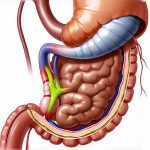Most people experience occasional digestive upset – a feeling of fullness after eating too quickly, bloating after a particularly gassy meal, or general discomfort in the upper abdomen. These are commonly referred to as indigestion or simply “having gas,” and typically resolve on their own with simple adjustments like dietary changes or over-the-counter remedies. However, when these symptoms become persistent, frequent, and significantly impact quality of life, it’s important to investigate further. The distinction between transient digestive discomfort and a chronic condition is often blurry, leading many individuals to underestimate the potential for underlying issues. This article will explore functional dyspepsia, a complex gastrointestinal disorder that goes beyond typical indigestion, explaining its characteristics, causes, diagnosis, and management strategies – all while emphasizing the importance of consulting with a healthcare professional.
Functional dyspepsia isn’t simply “a bad stomach”; it represents a disruption in how the digestive system functions, even when no visible structural or biochemical abnormalities are present through standard testing. While occasional indigestion is often linked to specific triggers like food intolerance or overeating, functional dyspepsia persists despite dietary modifications and symptom management techniques. It’s crucial to understand that this isn’t “all in your head,” but rather a real medical condition characterized by altered gastrointestinal motility, visceral hypersensitivity (increased perception of normal digestive processes as painful), and often psychological factors that can exacerbate symptoms. Recognizing the difference between episodic discomfort and chronic dysfunction is the first step toward appropriate evaluation and care.
Understanding Functional Dyspepsia
Functional dyspepsia is defined clinically – meaning it’s diagnosed based on symptoms rather than specific test results. It’s characterized by persistent or recurrent pain or discomfort in the upper abdomen, often described as burning, aching, or fullness. These symptoms must be present for at least three months and not relieved solely by acid-suppressing medications. There are several subtypes of functional dyspepsia, broadly categorized as:
- Postprandial Distress Syndrome (PDS): Symptoms primarily occur after eating, including bloating, early satiety (feeling full quickly), and fullness post meals.
- Epigastric Pain Syndrome (EPS): Predominantly involves pain or burning in the upper abdomen, not necessarily related to eating.
These subtypes can overlap, meaning someone may experience symptoms of both PDS and EPS simultaneously. The precise cause of functional dyspepsia remains elusive – it’s thought to be multifactorial, involving a complex interplay between physiological and psychological factors. It’s not caused by ulcers, inflammation, or cancer, as these would be detectable through standard diagnostic testing. However, the absence of these conditions doesn’t negate the very real suffering experienced by individuals with functional dyspepsia. The disorder represents a disruption in normal digestive processes, leading to uncomfortable and often debilitating symptoms.
The prevalence of functional dyspepsia is estimated to range from 5-20% of the population, making it one of the most common functional gastrointestinal disorders (FGIDs). It can affect people of all ages, but seems to be more prevalent in younger adults. Women are disproportionately affected compared to men. While the exact reasons for this disparity aren’t fully understood, hormonal fluctuations and differences in pain perception may play a role. Importantly, it’s not contagious and doesn’t typically lead to serious complications like other gastrointestinal diseases. However, its chronic nature can significantly impact daily life, leading to anxiety, depression, and reduced quality of life. If you suspect your gut issues are functional or structural, seeking professional guidance is critical.
Differentiating From Typical Indigestion & Gas
Typical indigestion or gas is usually acute and directly related to identifiable triggers. Overeating, consuming fatty foods, carbonated beverages, or specific food intolerances are common culprits. The symptoms tend to be short-lived and resolve with simple measures like antacids, dietary modifications, or allowing the digestive system time to process the offending food. Gas, similarly, is a normal byproduct of digestion and can often be relieved by passing it or making changes to one’s diet to reduce gas-producing foods. The key difference lies in persistence and severity. Indigestion or gas that occurs sporadically and doesn’t interfere with daily activities generally isn’t cause for concern.
Functional dyspepsia, on the other hand, is chronic. Symptoms occur frequently – sometimes daily – and are often resistant to over-the-counter remedies. While dietary changes may offer some relief, they rarely eliminate symptoms entirely. The pain or discomfort associated with functional dyspepsia can be more intense and debilitating than typical indigestion, often interfering with work, social activities, and sleep. Furthermore, the psychological impact of chronic digestive symptoms should not be underestimated; anxiety about when symptoms will occur, fear of eating in public, and feelings of helplessness are common among individuals with functional dyspepsia. Understanding dyspepsia can help you navigate these challenges.
Another crucial distinction is the lack of identifiable organic causes. In cases of typical indigestion, underlying conditions like gastroesophageal reflux disease (GERD) or lactose intolerance might be identified through testing. Functional dyspepsia is a diagnosis of exclusion, meaning other potential causes have been ruled out. This can sometimes lead to frustration for patients who are seeking a clear-cut explanation for their symptoms and may feel dismissed if tests come back normal. It’s vital to remember that a negative test result doesn’t invalidate the experience; it simply confirms that the source of the problem lies in altered digestive function rather than structural abnormalities.
Diagnostic Approaches
Diagnosing functional dyspepsia requires a careful assessment by a healthcare professional, typically a gastroenterologist. The process usually begins with a detailed medical history and physical examination to rule out other potential causes of abdominal discomfort. This includes questions about symptoms (location, severity, timing, triggers), dietary habits, medications, family history, and psychological factors. A crucial part of the diagnostic process is often excluding more serious conditions through specific tests:
- Endoscopy: A procedure where a thin, flexible tube with a camera is inserted into the esophagus, stomach, and duodenum to visualize the lining and check for ulcers, inflammation, or tumors.
- Helicobacter pylori testing: To rule out infection with this bacterium, which can cause gastritis and peptic ulcer disease. Testing may involve blood tests, stool tests, or a breath test.
- Celiac disease screening: Blood tests to check for antibodies associated with celiac disease, an autoimmune disorder triggered by gluten.
If these tests are negative and the symptoms meet the diagnostic criteria for functional dyspepsia (persistent or recurrent upper abdominal discomfort for at least three months), a diagnosis can be made. It’s important to note that there isn’t one single test to confirm functional dyspepsia; it’s primarily a clinical diagnosis based on symptom assessment and exclusion of other conditions. Advanced testing, like gastric emptying studies or manometry (measuring pressure within the digestive tract), may sometimes be used in complex cases to further evaluate digestive function. You can learn more about flexible sigmoidoscopy as part of the diagnostic process, though it is not typically used for this condition.
Management Strategies
Managing functional dyspepsia often requires a multifaceted approach tailored to the individual’s specific symptoms and triggers. There is no “cure” for functional dyspepsia, but symptoms can be effectively managed through a combination of lifestyle modifications, dietary changes, medications, and psychological therapies. Lifestyle adjustments include stress management techniques (yoga, meditation, deep breathing exercises), regular exercise, and getting adequate sleep. Dietary changes may involve identifying and eliminating trigger foods, eating smaller, more frequent meals, avoiding fatty or spicy foods, and limiting carbonated beverages.
Pharmacological interventions are often used to manage specific symptoms:
- Prokinetic agents: Medications that help speed up gastric emptying and improve digestive motility.
- Acid-suppressing medications: While not always effective in functional dyspepsia (as it’s not typically caused by excess acid), they may provide relief for some individuals with overlapping GERD symptoms.
- Antispasmodics: To reduce abdominal cramping and bloating.
- Low-dose antidepressants: Certain antidepressants, even at low doses, can help modulate pain perception and reduce visceral hypersensitivity.
Psychological therapies, such as cognitive behavioral therapy (CBT) and gut-directed hypnotherapy, have shown promise in managing functional dyspepsia by addressing the psychological factors that can exacerbate symptoms and helping individuals develop coping strategies. A collaborative approach between a healthcare professional and the individual is essential for developing an effective management plan. If you experience dry mouth alongside these symptoms, it’s important to discuss this with your doctor.
The Role of Gut Microbiome & Future Research
Emerging research suggests that the gut microbiome – the community of microorganisms living in our digestive tract – may play a significant role in functional dyspepsia. Alterations in the composition and diversity of the gut microbiome have been observed in individuals with FGIDs, including functional dyspepsia. These alterations can affect gut motility, inflammation, and visceral sensitivity. While more research is needed to fully understand this relationship, strategies aimed at improving gut health – such as consuming a diet rich in fiber and fermented foods, and potentially using probiotics or prebiotics – may offer benefits for some individuals with functional dyspepsia. Understanding how gut inflammation impacts these conditions is also an area of active research.
Future research efforts are focused on identifying biomarkers for functional dyspepsia to improve diagnosis and predict treatment response. Understanding the underlying mechanisms that drive this complex disorder is crucial for developing more targeted and effective therapies. Ultimately, a holistic approach that addresses both the physical and psychological aspects of the condition will be key to improving the quality of life for individuals living with functional dyspepsia. Remember to always consult with your healthcare provider for personalized advice and treatment options. If you experience pain after eating, it’s important to seek medical evaluation to rule out other causes. Finally, recognizing and treating functional bloating can be an integral part of managing this condition.


















